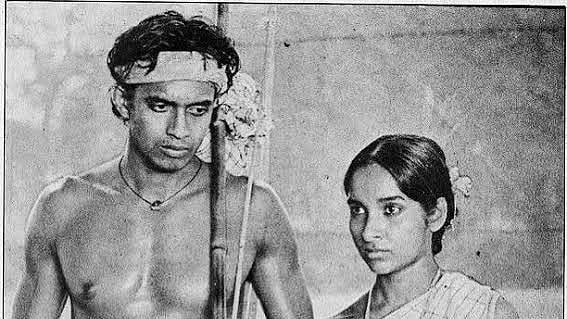
The first time I approached Mithun Chakraborty almost three decades ago, he asked gravely, “So, why do you want to interview me?” Taken aback, I pointed out that he was one of Hindi cinema’s top stars. Looking disappointed, he retorted that there were bigger stars than him. “Yeah, but they haven’t won two National Awards,” I reasoned, and a rare smile lit his face. I got my interview in which he shared that after being adjudged best actor for the second time for Buddhadeb Dasguta’s ‘Tahader Katha’, he had walked all the way up to Vaishno Devi temple without any break. Recently, when the Dadasaheb Phalke Award was announced, sparking a debate about whether he deserved the highest honour for cinema, not many remembered ‘Shibnath’, the freedom fighter from this 1992 Bengali film who, unwilling to sell his patriotism for a job, retreats further into his fragile, fractured mind.
Even his portrayal of Ramakrishna Paramahansa in G V Iyer’s 1998 biographical drama, ‘Swami Vivekananda’, which won Mithun a third National Award, has been largely forgotten. Only Mrinal Sen’s 1976 cult film, ‘Mrigaya’, remains a talking point even though it didn’t kickstart his Bollywood career. The National Award winner struggled for two years, doing stage shows under the pseudonym Rana Rez, before a goat headbutted him to box office success. ‘Mera Rakshak’ was followed by another hit, ‘Surakksha’ and Agent Gopi aka Gun Master G9 proved to B-town’s sceptics that the Adivasi, dhoti-clad archer from ‘Mrigaya’ could be accepted as a suited-booted desi Bond too. And just like that, without applauding critics or blaring trumpets, he quietly bridged the divide between mainstream and parallel cinema at a time when the two worlds were distinctly apart.
Sucked into Bengal’s Naxal movement in the ’60s, pursued by cops in Kolkata, Gouranga Chakraborty had fled to Pune and found refuge in the FTII from which he graduated in 1973 with a gold medal. However, the gold we flashback to today are his costumes from B Subhash’s ‘Disco Dancer’. The filmmaker had sketched out the rags-to-riches story of a street singer to cheer up his ‘Taqdeer Ka Badshah’ hero who was reeling after two dozen flops. Neither imagined the 1982 musical would not only make him a household name across India, but even Russians singing ‘Jimmy Jimmy’ on the streets of Moscow and China voting it the ‘Film of the Decade’.
As the Indianised Michael Jackson, Mithun was back in the race and even though he was disparagingly called the ‘poor man’s Bachchan’, the only competition for the Shahenshah. In fact, he won his first Filmfare Award for Best Supporting Actor for his portrayal of a coconut seller, Krishna Iyer M A, in the Bachchan-starrer ‘Agneepath’. Unstoppable, he entered the Limca Book of Records for acting in 19 films in a single year — 1989. He did more than a hundred films in the eighties. Quantity over quality took a toll and in 1992, Mithun announced he was going to quit films. His sister and a cousin had already renounced the world, he wanted to go down the same path too. “Maybe after five years I will become a sanyasi,” he had said.
Destiny ensured he stayed in this world, and wonderworld, though he moved from Mumbai’s maddening crowds to serene Ooty where he built his hotel, brought up his children, and shot many of his films within a month, in a limited budget, and ensured none of his filmmakers lost money. If they did, they were compensated, which explains how he spearheaded a parallel industry and ended up doing almost 400 films.
At 74, IMDb lists eight upcoming films. During our last interview in 2023, he admitted that earlier he’d get fever, even dysentery, on the Friday of a release, but now, only wants his producer to earn back the money he has invested in the film. He also confided that he can’t do these kind of films, but when ekdum hatke films like ‘The Tashkent Files’, ‘The Kashmir Files’, ‘Projapati’ and ‘Kabuliwala’ come along, he does them with “full intensity and honesty”.
Filmmaker Vivek Agnihotri reveals that during ‘The Tashkent Files’, he learnt from his wife Yogita that Mithun had rehearsed diligently at home for three months to get every word and nuance right and on the last day had asked him a question which left him shellshocked, “You took me for a reason, have I passed the test?” That sums up Mithun Chakraborty whose immediate reaction to joining the galaxy of Phalke greats, including Devika Rani, Raj Kapoor, Dilip Kumar, Sivaji Ganesan, Amitabh Bachchan and fellow Bengalis Satyajit Ray, Tapan Sinha, Soumitra Chatterjee and Mrinal Sen, was a humble, “This proves what I always tell my fans, and those who aren’t financially strong: if I can make it, then you can too.”
(The author is a senior film journalist and writer)